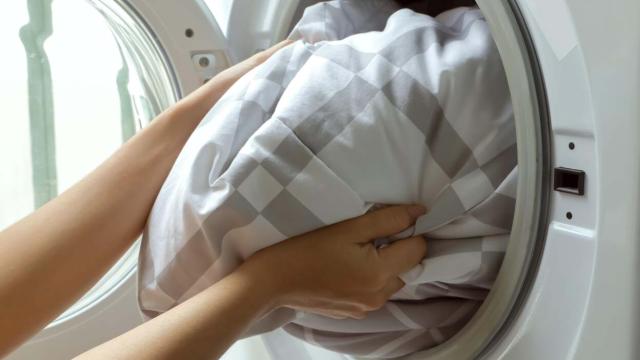People use weighted blankets for a variety of reasons. Research suggests that the therapeutic blankets, which weigh between five and 30 pounds, “may benefit people with anxiety, autism, and insomnia, among other conditions.” Using deep-pressure stimulation, the blankets relax the nervous system and mimic the experience of being held or hugged (think: baby swaddling, but for adults).
They may improve sleep quality and reduce stress, but trying to wash them can bring its own kind of stress. While the exterior fabric is usually something traditional like wool, cotton, flannel, linen, or rayon, the fill that makes it heavy “may include microfiber beads, sand, steel beads, pebbles, or grains.” (Other websites listed plastic or “poly” pellets and organic materials such as dehydrated food as potential fillers.)
So how do you safely clean a blanket made of such non-traditional materials?
How to wash your weighted blanket (in the machine)
First, a few general guidelines. The best way to wash a weighted blanket is to get a removable cover for it so you can wash that, instead of the the blanket itself. Avoid tossing it in for every stain or blemish; spot clean whenever possible. Use a gentle detergent while avoiding laundry aids such as fabric softener, bleach, vinegar, baking soda, or salt. Never wash or dry on high heat. Not only should you check the specific care instructions on your blanket’s label, adds Kristen Higgins, Henkel’s Consumer Product Testing Expert for Laundry, but you should also check your washing machine’s weight capacity. She points out most standard washers can only take up to 20 pounds. Even if your blanket weighs in under 20, don’t forget it’s about to be soaked with water, which will make it way heavier in there.
Generally, blanket containing glass beads are safe to wash in the machine; steel beads less so, as friction with the blanket’s outer fabric can lead to tearing and leaking of the blanket’s filler. Plastic pellets are washable, but care must be taken to avoid heat, as they can melt. If you want to attempt an in-machine wash, says Higgins, make sure you spot treat stains first, remove all any detachable covers or ties that come with the blanket, and always wash it alone. Use a gentle cycle with regular detergent and avoid fabric softener, “as it can damage the material of the blanket and add extra weight.” She recommends Purex Mountain Breeze, which she calls “dependable.”
If your blanket is over the weight limit for your washer, you may not have to skip straight to hand-washing, either. Higgins suggests checking local laundromats to see if any of them have commercial-sized washing machines. If so, you’re in luck—but still only wash the blanket on its own with no company.
Air drying is recommended. However, depending on the materials, your blanket may be able to sustain drying. For that, you may want to make a trip to a laundromat for a larger, commercial-size dryer. Always use low heat (unless manufacturer care instructions specify otherwise).
How to hand-wash your weighted blanket
If your blanket is too heavy for a machine or you just don’t want to risk it, you can always wash it by hand. Fill your tub with lukewarm water and let the blanket soak in a mild, bleach-free detergent for 15 to 30 minutes, agitating it occasionally with your hands. Then, drain the tub and rinse the blanket thoroughly. You might have to drain and refill the tub with clean water a few times to make sure all the detergent comes out.
When you’re finished, roll the blanket tightly to get as much water out as you can. Next, lay the blanket evenly on a surface to dry, while making sure the inner contents are distributed evenly.
When you should dry clean
Weighted blankets with organic fillers like corn, beans, rice, or sand should be left to a professional. Natural fillers don’t hold up well under water: they can become soggy or moldy, and sand will form clumps that make the blanket feel lumpy. Blankets made from wool, a fabric not known for having a great reaction to water, should also be left to your local dry cleaners.
How often should you wash your weighted blanket?
It depends. If you use it nightly, your blanket (or, preferably, its removable cover) should be washed every few weeks to eliminate sweat, oil, and bacteria buildup. If it’s only used occasionally for naps or TV watching, washing 4-6 times per year is sufficient. Avoid washing too frequently to preserve its longevity, durability, and the intended distribution of its filler. Too-frequent washes can cause the blanket to degrade more quickly, and increase the chances it will suffer a tear and spill its contents.

Leave a Reply
You must be logged in to post a comment.